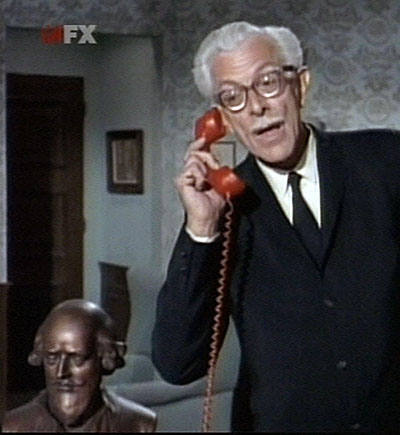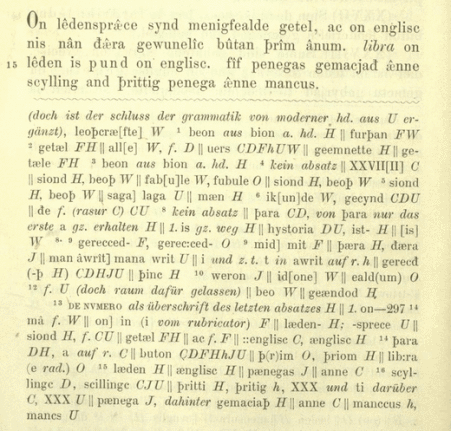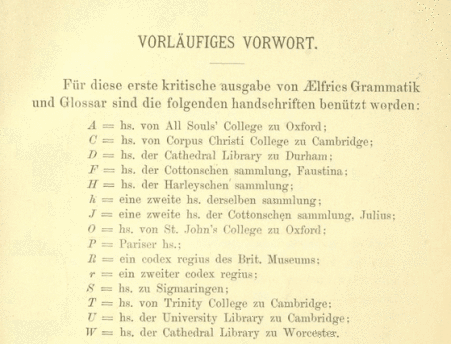Hello Stratford? Ælfric Calling!
Let us begin with considering the various manuscripts and a transcript of Ælfric’s Grammar, and who had access to them, and where they were then and now, and who the various players interested in those manuscripts were. For review, here’s the annotation from a copy of Lambarde’s Archaionomia (1568). The annotation is from Ælfric’s Grammar, written at the beginning of the 11th century.
click to enlarge
We found the same text here in this printed version from 1880. The footnotes collate the spelling variants among the extant medieval manuscripts.
click to enlarge
The spelling combinations of scillinge for shilling, XXX for thirty, and mancs for mancus, only exist in manuscript “U” – listed below.
click to enlarge
Manuscript U belonged to Mathew Parker, the Archbishop of Canterbury. He donated it to Cambridge in 1574. But we also needed to know if the annotation matched a transcript of Ælfric’s Grammar made by Laurence Nowell. We’ve managed to acquire an image of the relevant portion of that transcript, and it’s shown below.
click to enlarge
The spellings in the Nowell transcript are scylling, prittig and mancs. They do not match the annotation. Nor do they match any of the manuscripts listed in the 1880 edition of the Grammar. That is reasonable as the Nowell transcript is believed copied from a lost manuscript. Also, the Nowell transcript does not have the word-for-word portion that is mimicked in Shakespeare. Nowell simply has libra pund instead of libra onleden ys ƿund onenglise. The Nowell document does have an interesting manicule (pointing hand) on the left side of the page. I wonder if Nowell taught anyone how to draw manicules? But that is perhaps a topic for another post, or some other researchers.
I also managed to find an image of the passage in question from manuscript C, shown below. This one is close to the annotation, though it spells mancus instead of mancs. This manuscript was also owned by Mathew Parker. I’ve added this image to the set of rotating header graphics at The Festival Robe.
click to enlarge
Let’s examine some possibilities. And determine which are possible, probable, likely, or near certain. The first conclusion to make is that whoever made the annotation in Lambarde had Manuscript U beside them. The exact transcription makes that conclusion inescapable. And remember, Ælfric’s Grammar was specifically used when people wanted help translating Anglo-Saxon. But Lambarde had the translations built-in, with Latin on the opposing page. Perhaps the annotator wanted to have a go at practicing his Anglo Saxon translating skills. Either way, I think we must conclude that the annotator had access to manuscript U.
So – to the problem at hand. Would Edward de Vere likely have owned a copy of Lambarde’s Archaionomia? And could he have had access to Manuscript U from which to make the annotation from Ælfric’s Grammar that is later referenced in Shakespeare’s Love’s Labour’s Lost?
The materials for the Archainomia were compiled by Laurance Nowell and William Lambarde together prior to Nowell leaving for the continent. This work was done while Nowell lived in Cecil house. Cecil’s library is the logical location for that work. Edward de Vere lived in Cecil house at that same time. He would have been aware of the work, and possibly even assisted. When the book was printed in 1568, it would have been more than likely for him to be given a copy. I think it would have been unusual if he didn’t have a copy.
Mathew Parker owned two copies of Ælfric’s Grammar. Manuscripts C and U above. In this online article, Rebecca Brackmann details how one of the draws for Nowell to work for Cecil was giving him access to Parker’s manuscripts. Of Parker’s two copies of the Grammar, manuscript U has annotations of his secretary, John Joscelyn. Manuscript C was the one kept with his main collection and donated to Christ’s Church College of Cambridge. It seems that Manuscript U was his “B” copy, and more likely to be lent out. Here’s Brackmann.
“Some time in 1562 or 1563, Nowell was employed by Queen Elizabeth I’s secretary and one of the most powerful men in England, Sir William Cecil (later Lord Burghley), as a tutor to Cecil’s ward, Edward de Vere, the seventeenth earl of Oxford. Nowell lived in Cecil’s house from that time until 1567, even after his duties as a tutor were completed; Carl Berkhout speculates that Cecil employed him as a ‘scholarly factotum’.1 Cecil not only collected manuscripts himself, but had connections to other collectors such as archbishop of Canterbury Matthew Parker and dean of Canterbury Nicholas Wotton; it seems probable that Cecil’s influence opened doors for Nowell’s Anglo-Saxon studies by smoothing his way in borrowing manuscripts. Nearly all of Nowell’s manuscripts and notes concerning the study of Old English date from his time in Cecil’s house. While residing there, Nowell would also have come into contact with several prominent English humanists and writers of the day, such as Roger Ascham and Arthur Golding, placing his studies at the heart of Tudor political and literary culture. In 1567, Nowell left England to travel on the Continent and seek out manuscripts there. He did not return from this journey, and in 1571 the court of requests ordered that his bequests should be distributed to his heirs
It certainly seems reasonable that Manuscript U could have spent some time in Cecil house where de Vere would have had access to it. But what about after Nowell left for the continent. Would Lambarde have needed Manuscript U? Lambarde had Nowell’s transcript of Ælfric’s Grammar.
Rebecca Brackmann’s The Elizabethan Invention of Anglo Saxon England Laurence Nowell, William Lambarde, and the study of Old English contains a chapter on the interest in chorographies by both Nowell and Lambarde. The cataloging of Anglo Saxon place names was important work towards their nationalist ends. Lambarde worked on an Alphabetical Description of the Chief Places of England and Wales, a work that was never completed. Now here’s where it get interesting. Manuscript U contains earlier annotations by Robert Talbot (d. 1558.) The Cambridge Library describes them as – “Marginalia in the hand of Robert Talbot (d. 1558) are throughout, showing a special interest in place-names.” Lambarde would want to consult Manuscript U for those place names in compiling his Alphabetical Description, giving the Manuscript U a reason to be loaned to Cecil house by Parker.
This link has an image from Manuscript U from the Cambridge Library (but not from the page used for the annotation). The large hand annotations are by Parker. The smaller hand are John Joscelyn, Parker’s secretary.
So here’s our hypothetical. Nowell and Lambarde work together at Cecil house compiling the material for the Archainomia. Edward de Vere is present and possibly assists in the project. When the book is printed in 1568, de Vere, as a nobleman and potentail future patron of Lambarde is given a copy. de Vere then spends some time with it in Cecil’s library where Manuscript U is on loan from Parker. He makes the annotation in the Archaionomia. Years later, de Vere is writing Love’s Labour’s Lost. He’s including references to various grammarians. He wants to reference Ælfric, but he no longer has access to any manuscripts. He does however have that scrap that he copied into the Archaionomia years earlier. He uses it.
And that’s how a reference from an 11th century Anglo Saxon grammarian made it into Shakespeare’s Love’s Labour’s Lost.
It’s time now for Ælfric to make a call to Stratford and hear their version of the story. I’m expecting comedy, or more likely silence.
“MOTH
[Aside to COSTARD] They have been at a great feast
of languages, and stolen the scraps.
COSTARD
O, they have lived long on the alms-basket of words…”
LLL Act 5, sc i








4 comments
Hey Chris,
Terrific follow up on your previous blog entries. Very exciting and original work here, all enabled by the communications and research revolution known as the internet. A question: do you have, or can you get hold of, some samples of John Joscelyn’s handwriting, both italic and AS? It seems important to have a fix on what his writing looked like as he’s an obvious suspect, along with Lambarde, for the annotator of the Lambarde volume. I’m working up a blog posting that will consider the possibility that Lambarde could be the annotator of his own book (such things were not at all uncommon in those days), but it also seems important to rule out (or confirm as the case may be) Joscelyn. Thanks again for the great work!
never mind, I wrote this before finishing the entry, I see that you have a link to it. Great job!
Quick response: we need if possible a bigger sample from Joscelyn. Based on this sample its easy to rule out Parker but not Joscelyn. His hand is definitely in the same ball park as the annotators. It could be him.
Yes – Joscelyn is an obvious possibility. I didn’t reproduce that image in the blog, as that page had specific copyright notice – better to just link to it.
Leave a Comment